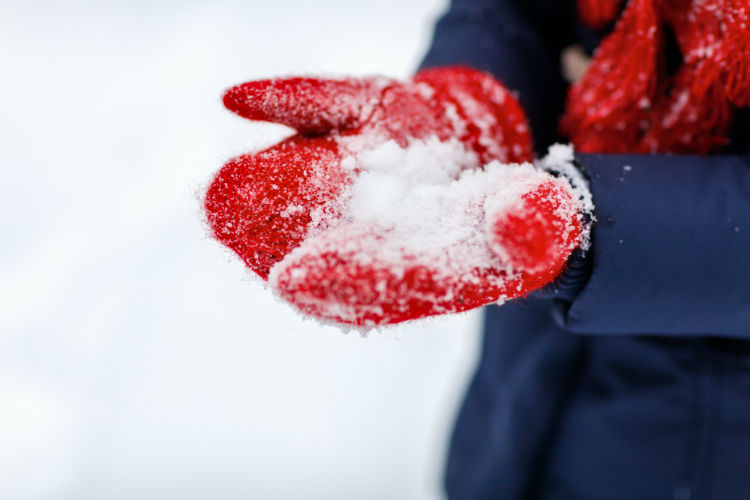Contrary to the popular jingle, Jack Frost doesn’t just nip—he often bites. To make matters worse, he doesn’t usually stop at your nose.
Harsh winter weather can be particularly damaging to sensitive older skin. Freezing temperatures and cold winds can quickly strip skin of its vital moisture, leaving it prone to itching, cracking and bleeding. Broken skin is a recipe for infection says Dr. Rebecca Baxt, a board-certified dermatologist and Fellow of the American Academy of Dermatology.
Unfortunately, even spending most of the colder months indoors adds to your skin’s suffering. According to Dr. James Marotta, a dual board-certified facial plastic surgeon based in Long Island, the same heating system that keeps you comfortable throughout winter also reduces the humidity level in your home.
Seniors Are More Susceptible to Skin Disorders
As we get older, normal age-related changes cause our skin to become thinner, drier and more fragile. Lifestyle factors, such as sun exposure, weight loss/gain, diet, stress and smoking, can also accelerate and/or exaggerate these changes. Our epidermis is meant to insulate and protect us from germs, injuries and the elements, but this outer covering loses its resilience over time. For example, conditions like skin cancer and senile purpura (skin that bruises easily) are two ailments that often strike the elderly, regardless of the season.
According to Dr. Baxt, harsh winter weather further compounds these problems, leaving older adults with itchy, irritated skin and certain types of rashes. There are two seasonal skin issues that physicians commonly see in seniors: asteatotic eczema and seborrheic dermatitis.
Asteatotic eczema (also called xerotic eczema or eczema craquelé) is highly seasonal and characterized by a dry, red, flaky rash that can occur on the legs, back and arms. Without treatment, the rash can worsen and result in cracks, fissures and sores that are susceptible to infection—especially if a senior is scratching the affected areas.
Seborrheic dermatitis is another skin condition that may flare up in winter. It is marked by patches of itchy, flaky skin, typically in oily areas like the scalp, eyebrows, nose and chest. Dr. Baxt explains that the yeast responsible for this skin disorder thrives at cooler temperatures and in low humidity.
6 Winter Skin Care Tips for Seniors
Fortunately, there are some steps that seniors and family caregivers can add to their skin care regimens to minimize discomfort and complications this winter. Drs. Baxt and Marotta offer the following essential tips for protecting senior skin in cold weather.
- Moisturize Regularly
Senior skin loses moisture much more easily, and dryness (xerosis) is a direct or contributing cause of many types of skin conditions. “It’s critical that people, especially elderly people, moisturize their skin in the winter months,” Dr. Baxt notes. While lotion may provide enough protection for some, seniors might want to seek out heavier creams or ointments. Just be sure to check the ingredients. Many heavy-duty emollient moisturizers contain lanolin, which some people may be sensitive to. Vaseline (petroleum jelly) is a skin saver if you can tolerate the greasy consistency.
Dr. Baxt suggests applying moisturizer immediately after showering to lock in vital hydration, and Dr. Marotta recommends immediately covering freshly moisturized areas with clothing (i.e. pants, a long-sleeve shirt, socks) to aid absorption. - Stay Hydrated
Most people assume that dehydration is only a concern during the hot summer months, but you can’t skimp on fluids just because it’s cold outside. Dr. Marotta suggests moisturizing from the inside out by drinking eight glasses of water a day (unless a senior has a medical condition that requires them to limit their fluids). One way to know if you’re getting enough water is to check your urine. Certain medications may affect urine color, but most people can aim for shades that lie somewhere in the range of pale to moderately yellow. - Bundle Up
Before braving the frigid outdoors, be sure to cover as much exposed skin as possible. The skin on your hands and feet is particularly susceptible to frostbite and windburn, and don’t forget to protect your ears, neck and face, too. Dress in warm layers and try to top them off with an insulating, windproof fabric in particularly cold and/or windy conditions. This will help prevent painful, chapped skin that can take a while to heal. - Wear Sunscreen
It may be a summertime staple, but Dr. Baxt emphasizes the importance of sunscreen even on cloudy winter days. Sun protection is especially important in areas prone to snow. UV rays easily reflect off of snow and can still cause damaging sunburns despite overcast or cloudy conditions. - Take Care When Bathing
As satisfying as a steamy shower can be on a cold winter’s night, Dr. Marotta warns against long, piping hot showers and baths. It may seem counterintuitive, but prolonged exposure to very hot water actually strips the skin of moisture and natural oils. Be mindful of the water temperature when bathing and washing your hands, limit time spent in the shower or bath, and try to use milder soaps and other bath products to minimize skin irritation and dehydration. - Embrace Humidity
Full room humidifiers can add moisture back to dry, artificially-heated air. Not only does this benefit your skin, but it can also soothe dry and inflamed airways and scratchy eyes. Just be sure to follow the manufacturer’s instructions for usage, cleaning and maintenance to avoid breathing in nasty germs like bacteria and mold.
If a senior is suffering from persistently dry, irritated winter skin, be sure to make an appointment with a dermatologist. These physicians specialize in treating skin conditions and can determine if something more serious is to blame. They can provide answers and treatment recommendations for quick relief.
